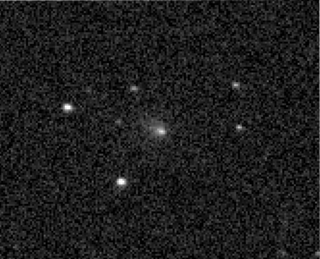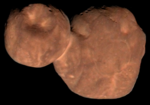Related Research Articles

32P/Comas Solà is a periodic comet with a current orbital period of 8.8 years.

10P/Tempel, also known as Tempel 2, is a periodic Jupiter-family comet with a 5-year orbital period. It was discovered on July 4, 1873 by Wilhelm Tempel. At the perihelion passage on 2 August 2026 the solar elongation is calculated at 164 degrees, with apparent magnitude approximately 8, with closest approach to Earth on 3 August 2026 at a distance of 0.414 AU (61.9 million km).
42P/Neujmin, also known as Neujmin 3, is a periodic comet 2 km in diameter.

52P/Harrington–Abell is a periodic comet in the Solar System.

84P/Giclas is a periodic comet in the Solar System. The comet nucleus is estimated to be 1.8 kilometers in diameter. In 1995 precovery images from three nights in September 1931 by Clyde W. Tombaugh were located.

105P/Singer Brewster is a periodic comet in the Solar System. It was discovered in 1986, and received the name of 1986d under the old naming system.
102P/Shoemaker, also known as Shoemaker 1, is a periodic comet in the Solar System. It was first seen in 1984 and then again in 1991. Images taken of it in 1999 were not recognized until 2006 when it was once again observed. It was unexpectedly dim in each of these returns.
138P/Shoemaker–Levy, also known as Shoemaker–Levy 7, is a faint periodic comet in the Solar System. The comet last came to perihelion on 11 June 2012, but only brightened to about apparent magnitude 20.5.
169/NEAT is a periodic comet in the Solar System. It is the parent body of the alpha Capricornids meteor shower in Late July. 169/NEAT may be related to comet P/2003 T12 (SOHO). 169P is a low activity comet roughly a few kilometers in diameter. It could have originated from the main asteroid belt.

166P/NEAT is a periodic comet and centaur in the outer Solar System. It was discovered by the Near Earth Asteroid Tracking (NEAT) project in 2001 and initially classified a comet with provisional designation P/2001 T4 (NEAT), as it was apparent from the discovery observations that the body exhibited a cometary coma. It is one of few known bodies with centaur-like orbits that display a coma, along with 60558 Echeclus, 2060 Chiron, 165P/LINEAR and 167P/CINEOS. It is also one of the reddest centaurs.

Comet Crommelin, also known as Comet Pons-Coggia-Winnecke-Forbes, is a periodic comet with an orbital period of almost 28 years. It fits the classical definition of a Halley-type comet with. It is named after the British astronomer Andrew C. D. Crommelin who calculated its orbit in 1930. It is one of only four comets not named after their discoverer(s), the other three being Comets Halley, Encke, and Lexell. It next comes to perihelion around May 27, 2039 when it will be near a maximum near-perihelion distance from Earth.

144P/Kushida is a periodic comet discovered in January, 1994, by Yoshio Kushida at the Yatsugatake South Base Observatory in Japan. This was the first comet discovery of 1994 and his second discovery within a month. It last came to perihelion on 25 January 2024, and brightened to about magnitude 10.

94P/Russell 4 is a periodic comet in the Solar System. It fits the definition of an Encke-type comet with. It was discovered by Ken Rusell on photographic plates taken by M. Hawkins on March 7, 1984. In the discovery images, Russell estimated that the comet had an apparent magnitude of 13 and a noticeable tail of 5 arc minutes. In the year of discovery, the comet had come to perihelion in January 1984.

43P/Wolf–Harrington is a periodic comet discovered on December 22, 1924, by Max Wolf in Heidelberg, Germany. In 2019 it passed within 0.065 AU of Jupiter, which lifted the perihelion point and increased the orbital period to 9 years.

62P/Tsuchinshan, also known as Tsuchinshan 1, is a periodic comet first discovered January 1, 1965 at the Purple Mountain Observatory in Nanking. It last came to perihelion on 25 December 2023 at around apparent magnitude 8, and was then 0.53 AU (79 million km) from Earth and 110 degrees from the Sun.

246P/NEAT is a periodic comet discovered on 2004 March 28 by Near-Earth Asteroid Tracking (NEAT) using the 1.2-metre (47 in) reflector at Haleakala. It was given the permanent number 246P on 2011 January 14.
51P/Harrington is a periodic comet in the Solar System.

C/2013 US10 (Catalina) is an Oort cloud comet discovered on 31 October 2013 by the Catalina Sky Survey at an apparent magnitude of 19 using a 0.68-meter (27 in) Schmidt–Cassegrain telescope. From September 2015 to February 2016 the comet was around apparent magnitude 6. The comet took around a million years to complete half an orbit from its furthest distance in the Oort cloud and should be ejected from the Solar System over many millions of years.

(323137) 2003 BM80, provisional designation: 2003 BM80 and cometary designation 282P/2003 BM80, is an asteroid and main-belt comet from the outer regions of the asteroid belt, approximately 9.4 kilometers (5.8 miles) in diameter. It was discovered on 31 January 2003 by astronomers of the LONEOS program conducted at Anderson Mesa Station near Flagstaff, Arizona, in the United States.
449P/Leonard is a periodic comet that orbits the Sun once every 6.83 years. Studies in 2022 show that 449P was a rediscovery of a previously lost comet that was spotted in 1987.
References
- 1 2 "IAUC 8429: C/2004 V3; C/2004 V4; 78P". IAU Central Bureau for Astronomical Telegrams. 2004-11-06. Retrieved 2012-02-28.
- ↑ "JPL Small-Body Database Browser: 163P/NEAT" (last observation: 2012-01-20). Jet Propulsion Laboratory . Retrieved 2012-02-28.
- 1 2 Syuichi Nakano (2011-10-12). "163P/NEAT (NK 2129)". OAA Computing and Minor Planet Sections. Retrieved 2012-02-28.
- 1 2 "163P/NEAT Orbit". Minor Planet Center . Retrieved 2014-06-18.
- ↑ Seiichi Yoshida (2011-10-01). "163P/NEAT". Seiichi Yoshida's Comet Catalog. Retrieved 2012-02-28.
- ↑ Maik Meyer (2004). "The precovery of comet 163P/2004 V4 (NEAT)". Catalogue of Comet Discoveries. Retrieved 2012-02-28.
- ↑ "MPEC 2004-X29 : COMET P/2004 V4 (NEAT)". IAU Minor Planet Center. 2004-12-08. Retrieved 2012-02-28.
- ↑ Seiichi Yoshida (2005-04-23). "163P/NEAT (2005)". Seiichi Yoshida's Comet Catalog. Retrieved 2012-02-28.
- ↑ "JPL Close-Approach Data: 163P/NEAT" (last observation: 2012-01-20). Retrieved 2012-02-28.




